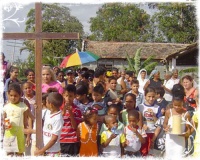5.4 Popular musical-religious Cuban festivities of the 17th century.

In the 17th century, the celebration of Corpus Christi grew throughout the island as Cuba’s main religious and popular festival, transforming into diverse forms throughout the country where it is celebrated. These festivities found a place and origin not only for music, but also for Cuban dance and theater of that era.
The festivities of the Cross of May or Altares de Cruz were widely celebrated in the central-eastern region of the country, primarily in Santiago de Cuba. This festival was deeply rooted in the popular tradition; it extended throughout the fifth month of the year. It was a family-oriented celebration and consisted of erecting altars in homes featuring the Holy Cross, surrounded by offerings of fruit and flowers in homage to spring. This was reminiscent of pagan festivals that had been adapted and transformed in Spain and brought to Cuba by the Spanish colonizers.
During these transcultural celebrations, the sound of African drums was heard, and the fervor of Black people in the expression of religious syncretism was evident, in a festival that is still prevalent in rural areas of the southeastern part of the country.
For example, in the community of San Pedro in Trinidad, there was a myth that taking the saint out into the streets on this day would bring the rains and end the drought and famine. Likewise, women who wet their faces with these first rains would stay young, beautiful, and fresh. The festival today consists of a large fair selling artisanal and industrial products, beverages and liquors, traditional foods, a procession of the patron saint, horseback riding tournaments, wake games, storytelling, riddles, controversies, country music gatherings, and daytime and nighttime dances. Although its origins are Catholic, over the years it has become a major popular festival in Cuba.
The forms of celebration varied from region to region. In the central and western regions, the Cuban Point was customary, and verses were improvised to the cross and saints.
The Cuban people in the 17th century sang and danced, and therefore took advantage of every opportunity to do so: processions, wakes, baptisms, secular and religious festivities, and private revelries.
During this period, one of the patron saint festivities that would eventually become emblematic was also born in the city of Santiago, giving rise to the Santiago Carnival.








